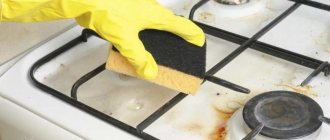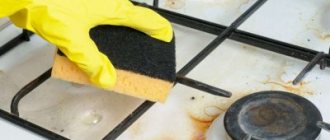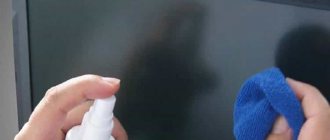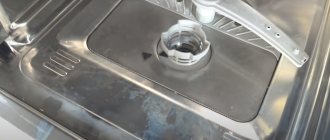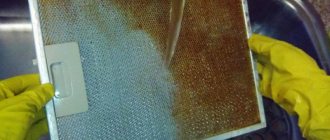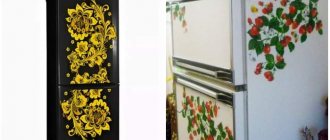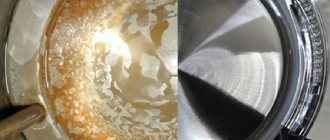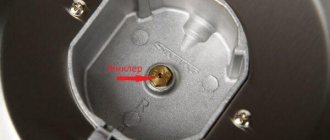General principles of care
The most correct option for caring for an electric stove is constant cleaning, which consists of regular wiping with a damp cloth after finishing cooking. But if you still cannot avoid the appearance of stains, and carbon deposits appear on the hob, then when the opportunity arises, you should start cleaning the device. Here it is important to know how to properly clean an electric stove without causing damage to it.
The principle of cleaning the electric stove and the preparations used depends on many factors:
- characteristics of the material;
- type of pollution;
- availability of additional components.
Features of electric glass-ceramic hobs
Glass ceramics are based on the use of ceran material, which is characterized by increased impact resistance and low thermal expansion.
For your information!
If water is poured onto the surface of a hot stove, cracks will not form due to temperature changes. The average service life at home, which is guaranteed by the manufacturer, is 15 years.
Typically, such stove models are equipped with halogen burners or a High Light system, in which heating is provided by means of a heating tape made of a special alloy located under the ceramics, wrapped in symmetrical rings.
Externally, glass ceramics is a perfectly smooth surface that has a pleasant appearance. Cooking food for a long time leads to the appearance of soot, grease stains and other difficult-to-remove contaminants. Therefore, every housewife will find useful information on how, and most importantly, how to clean a ceramic slab so that it retains its original appearance throughout its entire service life.
What not to do
Before considering methods for cleaning the stove and the materials that will be used, you need to understand for yourself what is prohibited from doing when cleaning the stove.
- Some housewives mistakenly think that heating the burners will help speed up and make it easier to clean up burnt-on food debris. To some extent this is true, but with this option you can simply damage the coating. For example, it will crack or become scratched. Therefore, even during preventative cleaning, you must wait until it cools completely.
- Do not scrape burnt-on food with metal scrapers, brushes or knives.
- Do not allow plastic elements of cookware to come into contact with a hot burner: if the plastic melts, it is very difficult to get rid of the marks. Below we will talk about one of the ways to remove plastic.
- You should not use aluminum cookware, as when heated it leaves marks on the burners that in most cases cannot be removed. If there is a need to use such dishes, then you need to buy a disk as an adapter or a grid.
- The surface of the electric stove is very susceptible to the use of low-quality cookware. If it leaves scratches, you should completely abandon it.
It is easier to get rid of dirt, including carbon deposits, at the moment it appears. Here, you can use any cleaning gel or dishwashing liquid as a product. It is spread with a sponge onto the contaminated area, left for 5-10 minutes, then washed off with water. To prevent streaks from appearing, remove moisture with a dry cloth. It is worth noting that all these tips are also relevant for cleaning induction cookers.
How to Clean a Stainless Steel Stove
Of course, a stainless steel electric stove looks very beautiful and impressive, but the polished coating quickly becomes covered with streaks and various stains. The easiest way to remove fresh dirt is to apply any appropriate soap solution to it and leave it for a certain period of time. If the coating is thick and strong enough, then you need to remove the soap solution and stain only after half an hour. The metal reacts well to any drugs, even with the most caustic composition.
If the situation is hopeless and you can’t clean the stove with a simple sponge and detergent, then as an exception you can use a brush, a wire sponge and paste. But this should only be done in rare cases.
How to tidy up your control panel
The control panel is the part that should always remain clean. However, this is where oil splashes, water drips, etc. often reach. Three-dimensional panels are subject to rapid loss of appearance, on which dirt literally settles on the rotary controls. You should also wash the space between the timer and clock buttons. All elements are washed only with the device turned off with a soft, slightly moistened cloth and soapy water.
The smartest automatic household appliances for the kitchen
How to care for a glass ceramic hob
Glass ceramics is a modern high-tech, aesthetically attractive material with many advantages and one significant drawback. It is delicate, fragile, you need to use and care for it carefully, following certain rules. During operation, grease stains, carbon deposits, and smudges inevitably appear on the surface. Keeping the panel clean is important not only for its attractive appearance, but also for maintaining its technical qualities.
The glass-ceramic panel must be cleaned according to an algorithm.
- The stove must be disconnected from the power supply.
- You need to walk directly over the hot surface with a special scraper to remove carbon deposits.
- Using a soft sponge or cloth, apply a detergent solution to the surface, paying attention to contaminated areas.
- The detergent must be removed with clean water. Rinse off until all the product is removed.
- Next, you should use a special glass and mirror cleaner and use it to polish the panel to a shine.
Glass ceramic care
To keep glass ceramics clean, you need to have at home:
- special scraper for glass ceramics;
- a soft sponge without abrasive;
- a cloth (preferably microfiber);
- detergent (without abrasive components);
- dry rags for the final stage of cleaning.
Some slabs come with a special scraper. If not, it must be purchased separately. These scrapers have a thin metal blade. It copes well with fresh soot from sweets, dried food residues, and burnt milk.
Advice! To remove old stains, it is better to use a melamine sponge (“eraser sponge”). It needs to be moistened and the old stain rubbed. Afterwards, the surface must be washed according to the traditional algorithm.
Melamine sponge
What household chemicals are suitable for caring for glass ceramics?
Cleaning will be better and easier if you use special cleaning products. Gels, liquids and pastes are suitable for glass ceramics. It is important that the structure of household chemicals is gentle and homogeneous, without abrasive inclusions that can damage the surface . Among the products recommended for glass ceramics, it is worth paying attention to Silit Beng, Shumanit, Comet and Sanita. Users praise imported products that also do a good job of caring for panels: a branded product from the manufacturer Miele, as well as Domax, Heitmann and Toprens. This is a universal chemistry that perfectly removes stains of various types: plaque, soot, grease.
You should work with detergents in this order.
- Read the instructions, especially if there are “attention” blocks.
- You should wear gloves when working with chemicals, ensuring good ventilation in the room.
- Apply the product to the panel and use a soft sponge to rub the dirty areas.
- Clean the surface of any remaining product using a damp cloth, then wipe it dry.
Important! The detergent must be completely removed from the surface by wiping it repeatedly with a clean, damp cloth. Chemical residues during heating of the stove can damage it.
To tidy up the stove, giving it a mirror shine, you can use window and mirror cleaners. A slab polished with these solutions will look like new.
An easy way to remove stuck plastic from your cooktop
Not the most popular situation, but it still happens: a piece of plastic sticks to a heated glass-ceramic surface. It looks terrible, and removing the melted plastic is not so easy. This is how you can clean glass ceramics.
- Prepare baking soda, a dish sponge and distilled white vinegar (you can find it on the shelves under the Heinz brand).
- The hob must cool completely to room temperature.
- Plastic soot should be generously sprinkled with soda, then poured with vinegar and left for 0.5 minutes or more.
- Use a napkin to carefully remove the plastic (it will “go limp” and come off normally). It is important to do this without pressing, without rubbing, so as not to damage the glass-ceramic surface with a hard plastic piece.
- Use a clean cloth to remove any remaining dirt.
conclusions
To summarize, it is worth saying that the most effective and cheapest cleaning will be the one that you carry out immediately after preparing food. Do not delay and wait until layers of dirt form on the hob and in the oven.
When choosing washing methods and household chemicals, follow the instructions . It contains all the manufacturer's recommendations specifically for each model of equipment. It is better to skip any initiative, as this can lead to extremely undesirable consequences.
Cleaning the handles
It is much easier to wash handles, switches and other small-sized elements when they are removed. They are soaked in soapy water and then cleaned with a sponge. A toothbrush will help clean dirt in hard-to-reach places. At the end, each element is rinsed and dried.
If you don’t have time for thorough cleaning, you can get by with superficial cleaning. For this procedure, it is best to take anise drops with ammonia. A cotton pad is moistened in the solution, and the necessary elements are evenly processed. After five minutes, the solution is washed off with a damp cloth, even with old stains that are difficult to remove.
Using folk recipes
If for some reason you cannot wash the device with water and cleaning solutions, then you can use other means that you have at hand. Among the most effective means are the following.
- Baking soda. The substance should not be used in dry form, as it may cause scratches. The best way to cook pasta is using water. If the stain does not disappear, then add a little vinegar to the solution.
- Vegetable oil. A rather unusual method that will help clean any material, even from carbon deposits. The oil should be distributed throughout the stain and left for 30-40 minutes. After the specified time, use a rubber scraper to wipe off the dirt. Then the remaining traces of oil are removed.
Using the tips provided, you can easily get rid of dirt on the slab for a long time and maintain its original attractive appearance. It should be noted that housewives often have problems with cleaning the oven. Of course, you can also use folk remedies or household chemicals for this. Or you can simply buy a stove with a pyrolytic cleaning function. This method perfectly fights greasy deposits without the need to use any effort. In comparison with catalysis and hydrolysis methods, it is the most modern and convenient.
Cleaning the oven
In electric stoves, depending on the model, the oven may have an enameled, bioceramic or stainless steel surface. Detergents are selected according to the internal coating.
- To wash cabinet walls with a stainless steel surface, you can use a solution of laundry soap or dishwashing detergent.
- To clean enameled and bioceramic surfaces, you can use baking soda, as well as household industrial chemicals that clean grease well.
Advice! The manufacturer of Gorenje stoves recommends using chemicals in the consistency of a spray, gel or paste, for example, Sanita Anti-grease, to care for an oven with SilverMatte enamel.
The walls of the cabinet, as well as the glass door, are treated with the product, and after 20-30 minutes they are washed with a rag and water. After cleaning, keep the oven slightly open to remove odors.
